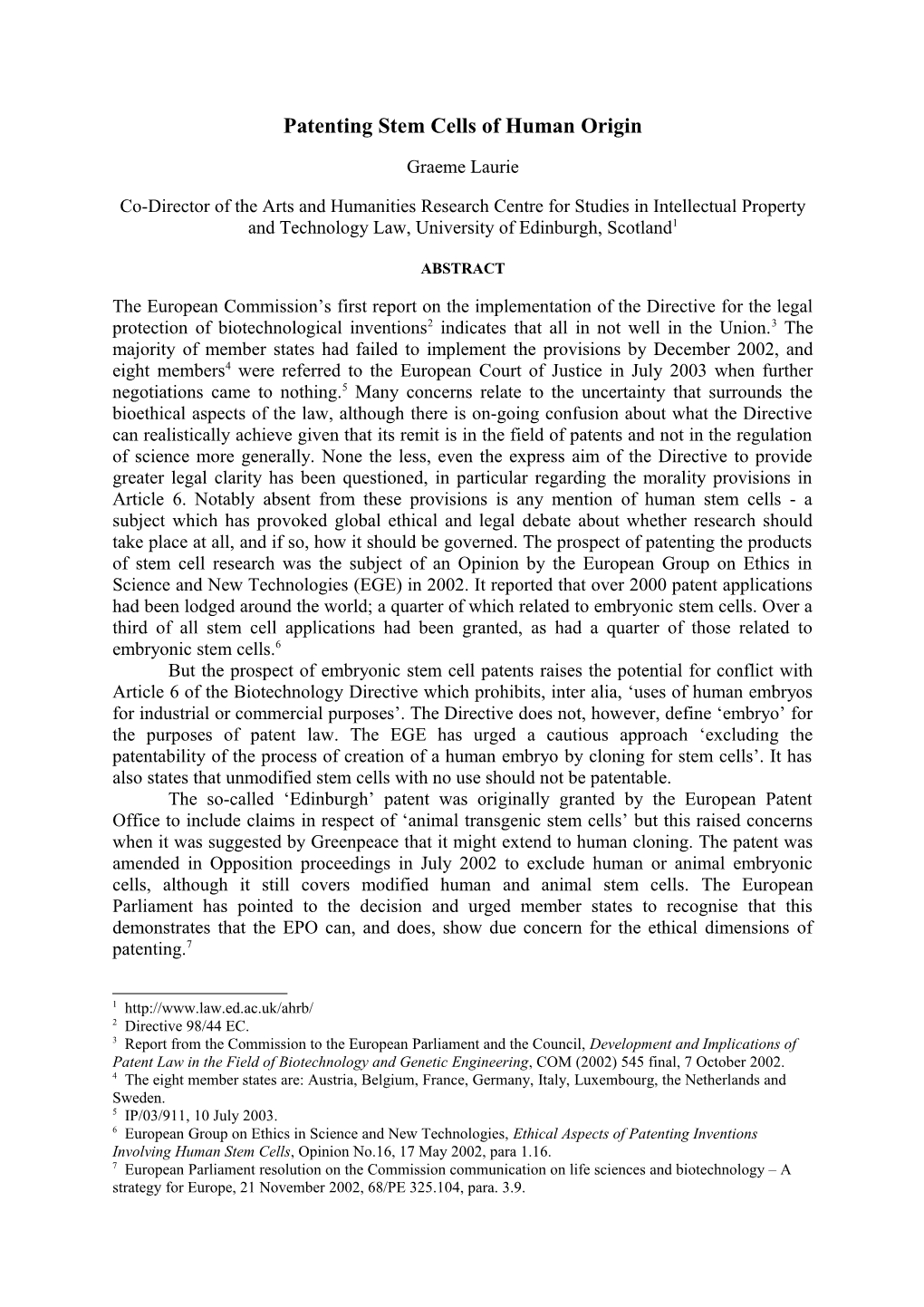Patenting Stem Cells of Human Origin
Graeme Laurie
Co-Director of the Arts and Humanities Research Centre for Studies in Intellectual Property and Technology Law, University of Edinburgh, Scotland[1]
ABSTRACT
The European Commission’s first report on the implementation of the Directive for the legal protection of biotechnological inventions[2] indicates that all in not well in the Union.[3] The majority of member states had failed to implement the provisions by December 2002, and eight members[4] were referred to the European Court of Justice in July 2003 when further negotiations came to nothing.[5] Many concerns relate to the uncertainty that surrounds the bioethical aspects of the law, although there is on-going confusion about what the Directive can realistically achieve given that its remit is in the field of patents and not in the regulation of science more generally. None the less, even the express aim of the Directive to provide greater legal clarity has been questioned, in particular regarding the morality provisions in Article 6. Notably absent from these provisions is any mention of human stem cells - a subject which has provoked global ethical and legal debate about whether research should take place at all, and if so, how it should be governed. The prospect of patenting the products of stem cell research was the subject of an Opinion by the European Group on Ethics in Science and New Technologies (EGE) in 2002. It reported that over 2000 patent applications had been lodged around the world; a quarter of which related to embryonic stem cells. Over a third of all stem cell applications had been granted, as had a quarter of those related to embryonic stem cells applications.[6]
But the prospect of embryonic stem cell patents raises the potential for conflict with Article 6 of the Biotechnology Directive which prohibits, inter alia, ‘uses of human embryos for industrial or commercial purposes’. The Directive does not, however, define ‘embryo’ for the purposes of patent law. The EGE has urged a cautious approach ‘excluding the patentability of the process of creation of a human embryo by cloning for stem cells’. It has also states that unmodified stem cells with no use should not be patentable.
The so-called ‘Edinburgh’ patent was originally granted by the European Patent Office to include claims in respect of ‘animal transgenic stem cells’ but this raised concerns when it was suggested by Greenpeace that it might extend to human cloning. The patent was amended in Opposition proceedings in July 2002 to exclude human or animal embryonic cells, although it still covers modified human and animal stem cells. The European Parliament has pointed to the decision and urged member states to recognise that this demonstrates that the EPO can, and does, show due concern for the ethical dimensions of patenting.[7]
This paper will consider the robustness of the current European patent provisions to meet the ethical and legal challenges posed by the prospect of patenting stem cells of human origin, with particular emphasis on embryonic stem cells.
[1] http://www.law.ed.ac.uk/ahrb/
[2] Directive 98/44 EC.
[3] Report from the Commission to the European Parliament and the Council, Development and Implications of Patent Law in the Field of Biotechnology and Genetic Engineering, COM (2002) 545 final, 7 October 2002.
[4] The eight member states are: Austria, Belgium, France, Germany, Italy, Luxembourg, the Netherlands and Sweden.
[5] IP/03/911, 10 July 2003.
[6] European Group on Ethics in Science and New Technologies, Ethical Aspects of Patenting Inventions Involving Human Stem Cells, Opinion No.16, 17 May 2002, para 1.16.
[7] European Parliament resolution on the Commission communication on life sciences and biotechnology – A strategy for Europe, 21 November 2002, 68/PE 325.104, para. 3.9.
